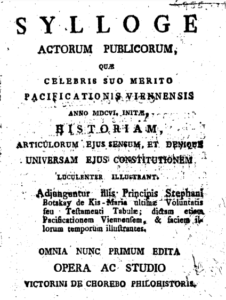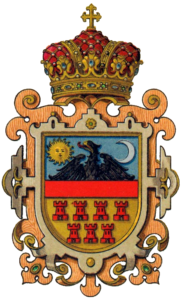Prince Rákóczi Zsigmond (1555-08/12/1608)

The founder of the great Rákóczi dynasty was born into a noble family in Felsővadász in Zemplén County around 1555. He appears in the sources for the first time around 1570, when he was a soldier in Szendrő, but in 1586 he was already the captain of the castle. He traded wine from his estates, especially to Poland, with which he amassed a considerable fortune. He also lent money to the Chief Captain of Kassa (Kosice, Kaschau), the Szepesi (Zipt) Chamber, through which he acquired Szerencs castle as a pledge.

Through his first wife, he acquired additional properties, thus becoming a large landowner. From 1588 he was the Chief Captain of Eger castle, and in this position, he participated in the victorious battle of Szikszó in the fall of that year. He also played a big role in achieving victory. In 1591, he left Eger and farmed and traded on his estates and acquired more important estates (Tarcal, Ónod, Szádvár, Sáros, Makovica). Here is my dramatized historical story about the Battle of Szikszó, it is in my book “33 Castles, Battles, Legends” but you can also read it here:

Around 1595, he was included in the royal council, thereby becoming one of the mightiest barons of the Kingdom of Hungary. However, he barely took part in the Fifteen Years’ War, and as a result of the Treasury lawsuit initiated against him by the Viennese court, he withdrew even more from public life. He returned to politics only at the Bocskai uprising. He joined Bocskai István at the end of 1604, and in September 1605 he was elected Governor of Transylvania during Bocskai’s absence.

He proved to be a very determined, strong-handed leader who was capable of making compromises at the same time. He was reliable, strong, and even combative when needed, respected others, and therefore quickly made many friends.
February 12th, 1607 Rákóczi Zsigmond was elected prince of Transylvania
On December 29, 1606, the Prince of Hungary and Transylvania Bocskai István died in Kassa. When his Last Will was read, it was discovered that he had named Homonnai Drugeth Bálint as his successor in Transylvania. However, his identity was kept secret for the time being, and it was taken for granted that the country, which had the right to elect its prince, would accept Bocskai’s Will without a word.

There were three candidates for the throne of Transylvania, Bocskai’s designated successor was Homonnai Drugeth Bálint, the former son-in-law of Rákóczi was the first. The second was Báthory Gábor, the son of the great princely dynasty, and the third was the Governor of Transylvania, Rákóczi Zsigmond. However, they did not take into account that Transylvania had been ruled by Rákóczi Zsigmond, who had been raised to a barony and had established very good relations with the local nobility, while Homonnai was not known at all.

When Rákóczi found out that the so-called Testamentary Gentlemen, Péchy Simon, secretary, Örvéndy Pál, treasurer, and Alvinczy Péter, pastor, who were in charge of the execution of the Will, did not respect the prince’s right of free choice, he called a meeting in Kolozsvár on January 22, 1607. The Estates declared themselves a Diet and organized a provisional government with Rákóczi and seven councilors. They sent ambassadors to the Sublime Porte and King Rudolph I of Hungary, ordered the mustering of the Borderland castles, and thus acted as a body with independent powers in all matters.

The Transylvanian Estates, who had the decision in their hands, decided to vote freely and cast their vote for Rákóczi, who was currently in Transylvania and had gained a good reputation. It was clear that Rákóczi, who had good relations with both the Hungarian nobility and the Székely and Saxon nobility, was the most likely candidate for the title of monarch. He did not refuse the opportunity. However, other names were also discussed, the most serious rival being Báthory Gábor, a descendant of the former ruling family. He even sent Bethlen to Transylvania to campaign for his princedom and even recruited some Hajdú soldiers, but Báthory was considered too young by the Estates. Bethlen and other supporters were arrested on Rákóczi’s orders. The Székelys were also called to war.

The success required the slowness of the other two candidates, as well as the decisive action of Rákóczi, who, while his rivals delayed, convened the assembly, where he was first confirmed in the position of Governor, and then elevated to the rank of prince. At the beginning of February, Bocskai’s funeral procession left for Kolozsvár. Homonnai and the Gentlemen of Bocskai’s Will had not yet heard of the decisions of the Diet, and on February 5th the news was brought to Tállya by the envoy of the Diet, which caused great surprise among them.

The Transylvanian Diet met again on February 8th. In the great church of Kolozsvár (Klausenburg, Cluj), Governor Rákóczi consecrated Homonnai to the nobility according to the Will. On February 12th the election of the prince took place:
“Since he is the elder, older and more respected among the nobles and nobility Estates, Sennyei Pongrác and Szilvási Boldizsár, and among the Székelys, Dersi Petki János, all the noblemen, being convinced of their affection, animosity, and liking, elected Governor Rákóczi as prince by a suffragium [declaration of will]… exclaiming: Vivat! Vivat! Although Rákóczi was reluctant to accept the nomination, citing his advanced age and illness, the Estates did not budge. Rákóczi then recited the oath and was escorted back to his quarters with great solemnity. Note, that Rákóczi gifted Petki for his service, look at his donation letter below:



Of course, the Estates saw a good opportunity to strengthen their power through the prince they chose. Laws were passed that curtailed the prince’s power, and theirs was significantly increased. During this time, Rákóczi tried to increase the number of his followers. He tried to make the Hungarian Székely border guards loyal by donating titles and promoting the Hajdú soldiers by settling them, but he also gave donations to others. Although he reigned in Transylvania for just over a year, he managed to issue several letters of nobility during this time. The letter of arms granted to Petky János (10 May 1607) is richly illustrated, and we show some beautiful excerpts from it.

You can read the details of the short reign of Báthory Gábor on my page:
https://www.hungarianottomanwars.com/essays/prince-bathory-gabor-of-transylvania-1589-1613/

Although there was no internal opposition, Homonnai and Báthory continued to strive for the throne. In May, Rákóczi and his former son-in-law met, and following their discussion, the nobleman from Upper Hungary (Homonnai) withdrew from the principality. However, Báthory did not rest. He recruited followers both in the kingdom and in Transylvania, while Rákóczi was still not supported by the Sublime Porte.

Rákóczi, who also soon developed an opposition that did not receive a land grant, slowly became isolated. Báthory rallied the Transylvanian opposition to his side and, with the tacit support of the Hajdús, the Turks, and the Habsburgs, he succeeded in forcing the old prince to resign. Rákóczi announced his resignation on March 5, 1608. He returned to his estates in Hungary but died at the end of the year (December 5) in Felsővadász. However, his name was so well known that twenty years later his eldest son György could easily succeed Bethlen Gábor. Now, Rákóczi Zsigmond rests in peace in the Reformed church in Szerencs.

Sources: Szibler Gábor (Oborni Teréz: Erdély fejedelmei. Pannonica, Bp., 2002. 77-85. Hangay Zoltán: Erdély választott fejedelme Rákóczi Zsigmond. Zrínyi, Bp., 1987.)
Perhaps you might like to read more about the interesting history of Felsővadász, the birthplace of Rákóczi Zsigmond:
https://www.hungarianottomanwars.com/1541-1699/1567-the-heroic-defenders-of-felsovadasz-castle/

Dear Readers, I can only make this content available through small donations or by selling my books or T-shirts.
If you like my writings, please feel free to support me with a coffee here:
You can check out my books on Amazon or Draft2Digital, they are available in hardcover, paperback, or ebook:
https://www.amazon.com/dp/198020490X
or at https://books2read.com/b/boYd81


My work can also be followed and supported on Patreon: Become a Patron!http://Become a Patron!




